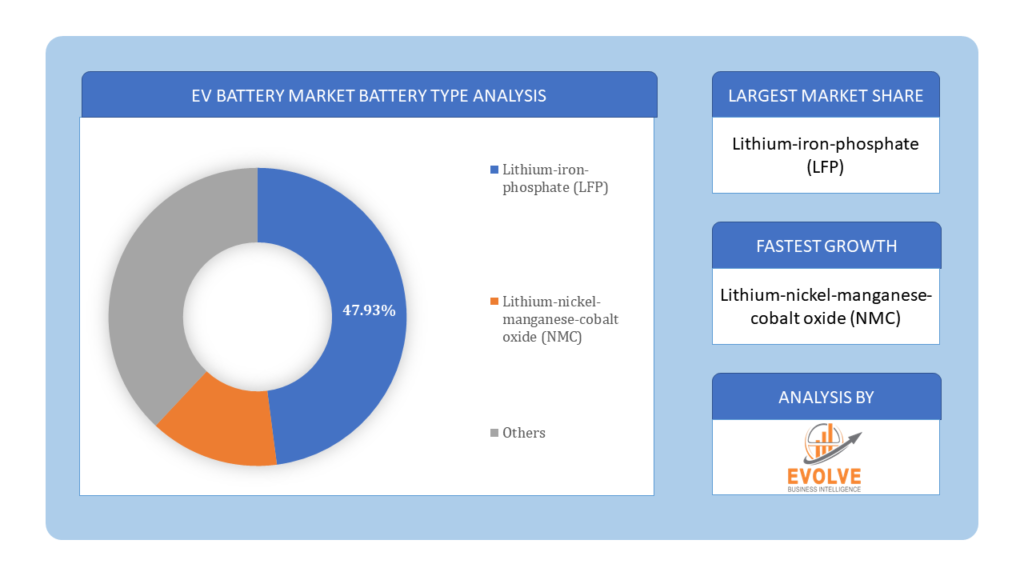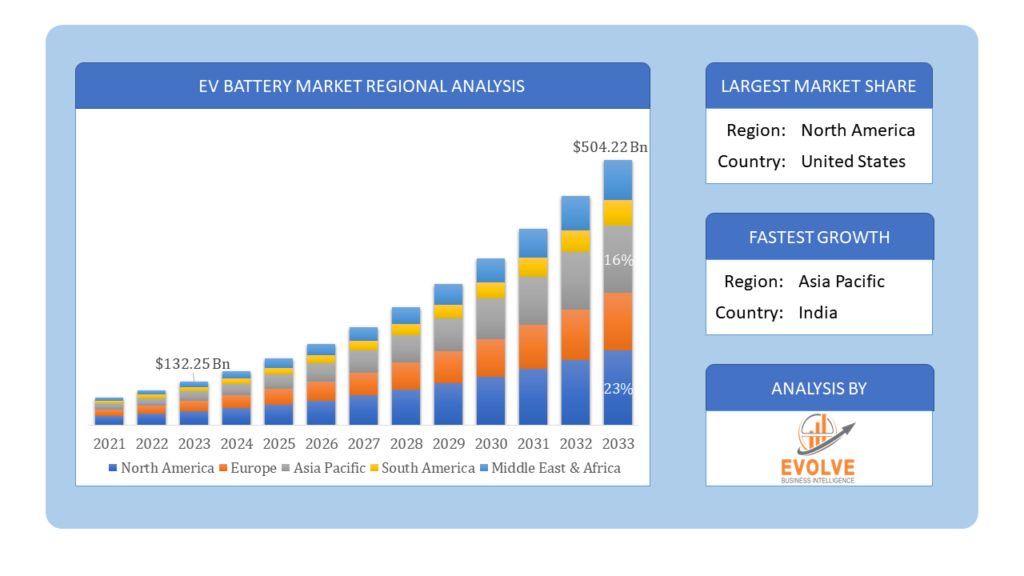EV Battery Market Analysis and Global Forecast 2023-2033
$ 1,390.00 – $ 5,520.00Price range: $ 1,390.00 through $ 5,520.00
EV Battery Market Research Report: Information By Battery Type (Lithium-Iron-Phosphate (LFP), Lithium-Nickel-Manganese-Cobalt Oxide (NMC), Others), By Component (Electric Motor, Ev Battery, Hydrogen Fuel Cell), and by Region — Forecast till 2033
Page: 99
EV Battery Market Overview
The EV Battery Market Size is expected to reach USD 504.22 Billion by 2033. The EV Battery industry size accounted for USD 132.25 Billion in 2023 and is expected to expand at a compound annual growth rate (CAGR) of 19.21% from 2023 to 2033. The electric commercial vehicle market refers to the market for commercial vehicles, such as pickup trucks, trucks, buses, and vans, that are powered by electric motors and rechargeable battery packs instead of traditional internal combustion engines.This market is expected to grow significantly in the coming years, with the global market size estimated to reach over $300 billion by 2030 at a CAGR of around 25%. The key drivers for this growth include the increasing adoption of electric vehicles due to their higher fuel efficiency, lower carbon emissions, and lower maintenance costs compared to conventional vehicles.The market is segmented by vehicle type, propulsion, battery type, battery capacity, power output, range, end-use, and region, with North America, Europe, and Asia-Pacific being the major regional markets.
Global EV Battery Market Synopsis
The electric commercial vehicle market witnessed a surge in demand during the COVID-19 Due to supply chain interruptions brought on by the COVID-19 epidemic, there are either shortages or decreased demand for electric commercial vehicles. Spending by consumers and businesses has decreased significantly as a result of the travel restrictions and social distancing measures, and this trend is expected to persist for some time. The epidemic has altered end-user trends and tastes, leading manufacturers, developers, and service providers to implement several measures in an attempt to stabilize their businesses.
EV Battery Market Dynamics
The major factors that have impacted the growth of EV Battery are as follows:
Drivers:
Ø Technological Advancements
Continuous advancements in battery technology, electric drivetrains, and vehicle efficiency are enhancing the performance, range, and reliability of electric commercial vehicles, making them increasingly competitive with traditional internal combustion engine vehicles.
Restraint:
- High Initial Costs
Despite the declining cost of battery technology, electric commercial vehicles still have higher upfront costs compared to their conventional counterparts. The initial investment required for purchasing electric trucks or vans, along with the cost of installing charging infrastructure, can be prohibitive for some fleet operators, particularly small and medium-sized businesses.
Opportunity:
⮚ Technological Innovation and Advancements
The electric commercial vehicle sector is characterized by rapid technological innovation, driven by ongoing research and development efforts. Advancements in battery technology, vehicle electrification, and charging infrastructure are opening up new possibilities for improving vehicle performance, range, and efficiency. Innovative solutions such as vehicle-to-grid (V2G) technology and smart charging systems present opportunities to optimize energy use and contribute to grid stability.
EV Battery Segment Overview
By Battery Type
 Based on Battery Type, the market is segmented based on Lithium-Iron-Phosphate (LFP), Lithium-Nickel-Manganese-Cobalt Oxide (NMC), Others. Lithium-Nickel-Manganese-Cobalt Oxide (NMC), favored for its high energy density and performance, and other battery chemistries. Each type offers distinct advantages, catering to different fleet requirements and applications, ranging from urban delivery to long-haul transportation, driving the market’s diversification and technological innovation.
Based on Battery Type, the market is segmented based on Lithium-Iron-Phosphate (LFP), Lithium-Nickel-Manganese-Cobalt Oxide (NMC), Others. Lithium-Nickel-Manganese-Cobalt Oxide (NMC), favored for its high energy density and performance, and other battery chemistries. Each type offers distinct advantages, catering to different fleet requirements and applications, ranging from urban delivery to long-haul transportation, driving the market’s diversification and technological innovation.
By Component
Based on Components, the market has been divided into the Electric Motor, Ev Battery, Hydrogen Fuel Cell. The Electric Vehicle Battery segment held the majority share in 2022 A rechargeable battery used to power the electric motors of a battery electric vehicle (BEV) or hybrid electric vehicle (HEV) is called an electric vehicle battery (EVB, often called a traction battery). The batteries used in electric vehicles are usually lithium-ion batteries with superior power-to-weight ratios and energy densities, as opposed to starting, lighting, and ignition (SLI) batteries.
Global EV Battery Market Regional Analysis
Based on region, the global EV Battery market has been divided into North America, Europe, Asia-Pacific, the Middle East & Africa, and Latin America. Asia Pacific is projected to dominate the use of the EV Battery market followed by the North America and Europe regions.
 Asia Pacific Market
Asia Pacific Market
Asia Pacific holds a dominant position in the EV Battery Market. The region’s dominance can be attributed to various factors. Asia Pacific led the global electric commercial vehicle market and is predicted to continue to do so throughout the projected period. The largest market for electric commercial vehicles is Asia Pacific. In addition, the market for electric commercial vehicles in the Asia-Pacific region is expanding quickly due to a number of factors including government initiatives, environmental laws, and rising consumer demand for eco-friendly transportation options. Electric trucks, buses, and vans are examples of commercial vehicles that run on electricity rather than conventional fossil fuels like gasoline or diesel. As part of its efforts to lower air pollution and carbon emissions, the Chinese government is encouraging the use of electric vehicles, making it the largest market for these vehicles in the Asia Pacific area.
North America Market
The North America region has indeed emerged as the fastest-growing market for the EV Battery industry. The North America region has indeed emerged as the fastest-growing market for the Electric Commercial Vehicle industry. The market for electric commercial vehicles (ECVs) is growing rapidly in North America as governments and companies strive to reduce emissions and improve sustainability in the transportation sector. The category of ECVs includes a variety of vehicle types, including delivery trucks, vans, buses, and other fleet vehicles. The number of electric commercial cars entering the North American market has increased significantly in recent years.
Competitive Landscape
The global EV Battery market is highly competitive, with numerous players offering a wide range of software solutions. The competitive landscape is characterized by the presence of established companies, as well as emerging startups and niche players. To increase their market position and attract a wide consumer base, the businesses are employing various strategies, such as Battery Type launches, and strategic alliances.
Prominent Players:
- Yutong
- Delphi Technologies
- VDL Group
- AB Volvo
- Toyota Kirloskar Motor
- NISSAN
- ITM Power
- Tesla
- Mitsubishi Electric Corporation
- HI ELECTRIC CORPORATION
Key Development
In September 2023, Nissan announced a significant milestone in the electric commercial vehicle market with the unveiling of its latest electric van model. Boasting advanced battery technology, improved range, and enhanced connectivity features, the new Nissan electric commercial vehicle aimed to redefine urban delivery and logistics, marking a strategic move towards sustainable transportation solutions.
Scope of the Report
Global EV Battery Market, by Battery Type
- Lithium-iron-phosphate (LFP)
- Lithium-nickel-manganese-cobalt oxide (NMC)
- Others
Global EV Battery Market, by Application
- Electric Motor
- EV Battery
- Hydrogen Fuel Cell
Global EV Battery Market, by Region
- North America
- US
- Canada
- Mexico
- Europe
- UK
- Germany
- France
- Italy
- Spain
- Benelux
- Nordic
- Rest of Europe
- Asia Pacific
- China
- Japan
- South Korea
- Indonesia
- Austalia
- Malaysia
- India
- Rest of Asia Pacific
- South America
- Brazil
- Argentina
- Rest of South America
- Middle East & Africa
- Saudi Arabia
- UAE
- Egypt
- South Africa
- Rest of Middle East & Africa
| Parameters | Indicators |
|---|---|
| Market Size | 2033: $504.22 Billion |
| CAGR | 19.21% CAGR (2023-2033) |
| Base year | 2022 |
| Forecast Period | 2023-2033 |
| Historical Data | 2021 |
| Report Coverage | Revenue Forecast, Competitive Landscape, Growth Factors, and Trends |
| Key Segmentations | Battery Type, Component |
| Geographies Covered | North America, Europe, Asia-Pacific, Latin America, Middle East, Africa |
| Key Vendors | Yutong, Delphi Technologies, VDL Group, AB Volvo, Toyota Kirloskar Motor, NISSAN, ITM Power, Tesla, Mitsubishi Electric Corporation, HI ELECTRIC CORPORATION |
| Key Market Opportunities | • Increasing logistic activities • Growth in demand within fleets |
| Key Market Drivers | • Government initiatives to encourage adoption of electric commercial vehicles. • Low operating cost |
REPORT CONTENT BRIEF:
- High-level analysis of the current and future EV Battery market trends and opportunities
- Detailed analysis of current market drivers, restraining factors, and opportunities in the future
- EV Battery market historical market size for the year 2021, and forecast from 2023 to 2033
- EV Battery market share analysis at each Battery Type level
- Competitor analysis with detailed insight into its Battery Type segment, Government & Defense strength, and strategies adopted.
- Identifies key strategies adopted including Battery Type launches and developments, mergers and acquisitions, joint ventures, collaborations, and partnerships as well as funding taken and investment done, among others.
- To identify and understand the various factors involved in the global EV Battery market affected by the pandemic
- To provide a detailed insight into the major companies operating in the market. The profiling will include the Government & Defense health of the company’s past 2-3 years with segmental and regional revenue breakup, Battery Type offering, recent developments, SWOT analysis, and key strategies.
Press Release

Global Pharmaceutical Manufacturing Market to Reach $1.38 Trillion by 2035 with 7.35% CAGR, New Research Shows

The Global Mammography Market Is Estimated To Record a CAGR of Around 10.29% During The Forecast Period

Glue Stick Market to Reach USD 2.35 Billion by 2034

Podiatry Service Market to Reach USD 11.88 Billion by 2034

Microfluidics Technology Market to Reach USD 32.58 Billion by 2034

Ferric Chloride Market to Reach USD 10.65 Billion by 2034

Family Practice EMR Software Market to Reach USD 21.52 Billion by 2034

Electric Hairbrush Market to Reach USD 15.95 Billion by 2034

Daily Bamboo Products Market to Reach USD 143.52 Billion by 2034

Cross-border E-commerce Logistics Market to Reach USD 112.65 Billion by 2034
Frequently Asked Questions (FAQ)
What is the study period of the EV Battery Market Overview?
The study period for the EV Battery Market Overview spans from 2023 to 2033.
What is the growth rate of the EV Battery Market Overview?
The EV Battery Market is expected to grow at a compound annual growth rate (CAGR) of 19.21% from 2023 to 2033.
Which region has the highest growth rate in the EV Battery Market Overview?
North America has emerged as the fastest-growing region in the EV Battery Market Overview.
Which region has the largest share of the EV Battery Market Overview?
Asia Pacific holds the largest share of the EV Battery Market Overview.
Who are the key players in the EV Battery Market Overview?
Key players in the EV Battery Market Overview include Yutong, Delphi Technologies, VDL Group, AB Volvo, Toyota Kirloskar Motor, Nissan, ITM Power, Tesla, Mitsubishi Electric Corporation, and HI Electric Corporation.
Do you offer Post sales support?
Yes, we offer 16 hours of analyst support to solve the queries
Do you sell particular sections of a report?
Yes, we provide regional as well as country-level reports. Other than this we also provide a sectional report. Please get in contact with our sales representatives.
Table of Content
Chapter 1. Executive Summary Chapter 2. Scope Of The Study 2.1. Market Definition 2.2. Scope Of The Study 2.2.1. Objectives of Report 2.2.2. Limitations 2.3. Market Structure Chapter 3. Evolve BI Methodology Chapter 4. Market Insights and Trends 4.1. Supply/ Value Chain Analysis 4.1.1. Raw Components Providers 4.1.2. Manufacturing Process 4.1.3. Distributors/Retailers 4.1.4. End-Use Industry 4.2. Porter’s Five Forces Analysis 4.2.1. Threat Of New Entrants 4.2.2. Bargaining Power Of Buyers 4.2.3. Bargaining Power Of Suppliers 4.2.4. Threat Of Substitutes 4.2.5. Industry Rivalry 4.3. Impact Of COVID-19 on the EV Battery Market 4.3.1. Impact on Market Size 4.3.2. End-Use Industry Trend, Preferences, and Budget Impact 4.3.3. Regulatory Framework/Government Policies 4.3.4. Key Players' Strategy to Tackle Negative Impact 4.3.5. Opportunity Window 4.4. Technology Overview 12.28. Macro factor 4.6. Micro Factor 4.7. Demand Supply Gap Analysis of the EV Battery Market 4.8. Import Analysis of the EV Battery Market 4.9. Export Analysis of the EV Battery Market Chapter 5. Market Dynamics 5.1. Introduction 5.2. DROC Analysis 5.2.1. Drivers 5.2.2. Restraints 5.2.3. Opportunities 5.2.4. Challenges 5.3. Patent Analysis 5.4. Industry Roadmap 5.5. Parent/Peer Market Analysis Chapter 6. Global EV Battery Market, By Battery Type 6.1. Introduction 6.2. Lithium-iron-phosphate (LFP) 6.3. Lithium-nickel-manganese-cobalt oxide (NMC) 6.4. Others Chapter 7. Global EV Battery Market, By Component 7.1. Introduction 7.2. Electric Motor 7.3. EV Battery 7.4. Hydrogen Fuel Cell Chapter 8. Global EV Battery Market, By Region 8.1. Introduction 8.2. North America 8.2.1. Introduction 8.2.2. Driving Factors, Opportunity Analyzed, and Key Trends 8.2.3. Market Size and Forecast, By Country, 2023-2033 8.2.4. Market Size and Forecast, By Battery Type, 2023-2033 8.2.5. Market Size and Forecast, By Component,2023-2033 8.2.6. US 8.2.6.1. Introduction 8.2.6.2. Driving Factors, Opportunity Analyzed, and Key Trends 8.2.6.3. Market Size and Forecast, By Battery Type, 2023-2033 8.2.6.4. Market Size and Forecast, By Component,2023-2033 8.2.7. Canada 8.2.7.1. Introduction 8.2.7.2. Driving Factors, Opportunity Analyzed, and Key Trends 8.2.7.4. Market Size and Forecast, By Battery Type, 2023-2033 8.2.7.5. Market Size and Forecast, By Component,2023-2033 8.3. Europe 8.3.1. Introduction 8.3.2. Driving Factors, Opportunity Analyzed, and Key Trends 8.3.3. Market Size and Forecast, By Country, 2023-2033 8.3.4. Market Size and Forecast, By Battery Type, 2023-2033 8.3.5. Market Size and Forecast, By Component,2023-2033 8.3.6. Germany 8.3.6.1. Introduction 8.3.6.2. Driving Factors, Opportunity Analyzed, and Key Trends 8.3.6.3. Market Size and Forecast, By Battery Type, 2023-2033 8.3.6.4. Market Size and Forecast, By Component,2023-2033 8.3.7. France 8.3.7.1. Introduction 8.3.7.2. Driving Factors, Opportunity Analyzed, and Key Trends 8.3.7.3. Market Size and Forecast, By Battery Type, 2023-2033 8.3.7.4. Market Size and Forecast, By Component,2023-2033 8.3.8. UK 8.3.8.1. Introduction 8.3.8.2. Driving Factors, Opportunity Analyzed, and Key Trends 8.3.8.3. Market Size and Forecast, By Battery Type, 2023-2033 8.3.8.4. Market Size and Forecast, By Component,2023-2033 8.3.9. Italy 8.3.9.1. Introduction 8.3.9.2. Driving Factors, Opportunity Analyzed, and Key Trends 8.3.9.3. Market Size and Forecast, By Battery Type, 2023-2033 8.3.9.4. Market Size and Forecast, By Component,2023-2033 8.3.11. Rest Of Europe 8.3.11.1. Introduction 8.3.11.2. Driving Factors, Opportunity Analyzed, and Key Trends 8.3.11.3. Market Size and Forecast, By Battery Type, 2023-2033 8.3.11.4. Market Size and Forecast, By Component,2023-2033 8.4. Asia-Pacific 8.4.1. Introduction 8.4.2. Driving Factors, Opportunity Analyzed, and Key Trends 8.4.3. Market Size and Forecast, By Country, 2023-2033 8.4.4. Market Size and Forecast, By Battery Type, 2023-2033 8.12.28. Market Size and Forecast, By Component,2023-2033 8.4.6. China 8.4.6.1. Introduction 8.4.6.2. Driving Factors, Opportunity Analyzed, and Key Trends 8.4.6.3. Market Size and Forecast, By Battery Type, 2023-2033 8.4.6.4. Market Size and Forecast, By Component,2023-2033 8.4.7. India 8.4.7.1. Introduction 8.4.7.2. Driving Factors, Opportunity Analyzed, and Key Trends 8.4.7.3. Market Size and Forecast, By Battery Type, 2023-2033 8.4.7.4. Market Size and Forecast, By Component,2023-2033 8.4.8. Japan 8.4.8.1. Introduction 8.4.8.2. Driving Factors, Opportunity Analyzed, and Key Trends 8.4.8.3. Market Size and Forecast, By Battery Type, 2023-2033 8.4.8.4. Market Size and Forecast, By Component,2023-2033 8.4.9. South Korea 8.4.9.1. Introduction 8.4.9.2. Driving Factors, Opportunity Analyzed, and Key Trends 8.4.9.3. Market Size and Forecast, By Battery Type, 2023-2033 8.4.9.4. Market Size and Forecast, By Component,2023-2033 8.4.10. Rest Of Asia-Pacific 8.4.10.1. Introduction 8.4.10.2. Driving Factors, Opportunity Analyzed, and Key Trends 8.4.10.3. Market Size and Forecast, By Battery Type, 2023-2033 8.4.10.4. Market Size and Forecast, By Component,2023-2033 8.5. Rest Of The World (RoW) 8.5.1. Introduction 8.5.2. Driving Factors, Opportunity Analyzed, and Key Trends 8.5.3. Market Size and Forecast, By Battery Type, 2023-2033 8.5.4. Market Size and Forecast, By Component,2023-2033 Chapter 9. Company Landscape 9.1. Introduction 9.2. Vendor Share Analysis 9.3. Key Development Analysis 9.4. Competitor Dashboard Chapter 10. Company Profiles 10.1. Yutong 10.1.1. Business Overview 10.1.2. Government & Defense Analysis 10.1.2.1. Government & Defense – Existing/Funding 10.1.3. Battery TypePortfolio 10.1.4. Recent Development and Strategies Adopted 10.1.5. SWOT Analysis 10.2. Delphi Technologies 10.2.1. Business Overview 10.2.2. Government & Defense Analysis 10.2.2.1. Government & Defense – Existing/Funding 10.2.3. Battery TypePortfolio 10.2.4. Recent Development and Strategies Adopted 10.2.5. SWOT Analysis 10.3. VDL Group 10.3.1. Business Overview 10.3.2. Government & Defense Analysis 10.3.2.1. Government & Defense – Existing/Funding 10.3.3. Battery TypePortfolio 10.3.4. Recent Development and Strategies Adopted 10.3.5. SWOT Analysis 10.4. AB Volvo 10.4.1. Business Overview 10.4.2. Government & Defense Analysis 10.4.2.1. Government & Defense – Existing/Funding 10.4.3. Battery TypePortfolio 10.4.4. Recent Development and Strategies Adopted 10.12.28. SWOT Analysis 10.5. Toyota Kirloskar Motor 10.5.1. Business Overview 10.5.2. Government & Defense Analysis 10.5.2.1. Government & Defense – Existing/Funding 10.5.3. Battery TypePortfolio 10.5.4. Recent Development and Strategies Adopted 10.5.5. SWOT Analysis 10.6. NISSAN 10.6.1. Business Overview 10.6.2. Government & Defense Analysis 10.6.2.1. Government & Defense – Existing/Funding 10.6.3. Battery TypePortfolio 10.6.4. Recent Development and Strategies Adopted 10.6.5. SWOT Analysis 10.7. ITM Power 10.7.1. Business Overview 10.7.2. Government & Defense Analysis 10.7.2.1. Government & Defense – Existing/Funding 10.7.3. Battery TypePortfolio 10.7.4. Recent Development and Strategies Adopted 10.7.5. SWOT Analysis 10.8 Tesla 10.8.1. Business Overview 10.8.2. Government & Defense Analysis 10.8.2.1. Government & Defense – Existing/Funding 10.8.3. Battery TypePortfolio 10.8.4. Recent Development and Strategies Adopted 10.8.5. SWOT Analysis 10.9 Mitsubishi Electric Corporation 10.9.1. Business Overview 10.9.2. Government & Defense Analysis 10.9.2.1. Government & Defense – Existing/Funding 10.9.3. Battery TypePortfolio 10.9.4. Recent Development and Strategies Adopted 10.9.5. SWOT Analysis 10.10. HI ELECTRIC CORPORATION 10.10.1. Business Overview 10.10.2. Government & Defense Analysis 10.10.2.1. Government & Defense – Existing/Funding 10.10.3. Battery TypePortfolio 10.10.4. Recent Development and Strategies Adopted 10.10.5. SWOT Analysis
Connect to Analyst
Research Methodology









